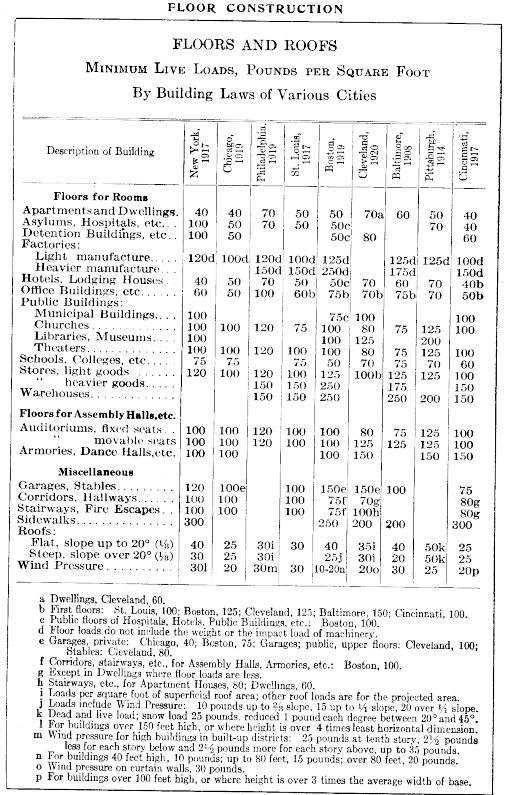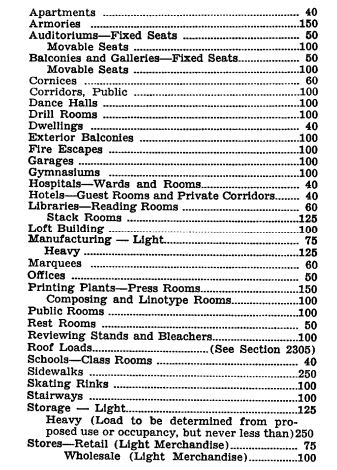I am looking for reference(s) that provide logic behind the magnitude of floor live loads provided in the building code. For example: How was it determined that corridor floor live load is 100 psf or hospital operating room is 60 psf and so on. Appreciate the help. Thx.
Navigation
Install the app
How to install the app on iOS
Follow along with the video below to see how to install our site as a web app on your home screen.
Note: This feature may not be available in some browsers.
More options
Style variation
-
Congratulations MintJulep on being selected by the Eng-Tips community for having the most helpful posts in the forums last week. Way to Go!
You are using an out of date browser. It may not display this or other websites correctly.
You should upgrade or use an alternative browser.
You should upgrade or use an alternative browser.
Origin of Building Code floor live loads 1
- Thread starter gtmc
- Start date
- Status
- Not open for further replies.
LittleInch
Petroleum
Given that the average American has increased in weight by nearly 20% over the last 60 years, you wonder if that gets taken into consideration...
Remember - More details = better answers
Also: If you get a response it's polite to respond to it.
Remember - More details = better answers
Also: If you get a response it's polite to respond to it.
Lomarandil
Structural
I don't know about that LittleInch, but when I was designing a stair for vibration in SE Asia with US documents as a reference, I felt pretty confident reducing the magnitude of the forcing function by 20%.
It was also accessing a mezzanine with 5'-9" ceilings... so lots of big foreigners wouldn't have felt comfortable up there anyway.
It was also accessing a mezzanine with 5'-9" ceilings... so lots of big foreigners wouldn't have felt comfortable up there anyway.
The live loads have been about the same since "Minimum Live Loads Allowable for Use in Design of Buildings", U.S. Department of Commerce, November 1, 1924. A scan is out there somewhere, should be findable via Google. I don't think it has any commentary though.
-
1
- #7
- Thread starter
- #9
jerseyshore
Structural
The 1916 NYC code uses very similar loads to what we use today. Simpler times back then. But I don't think they have much commentary in there about it so the typical 40, 50, 100 psf loads were from before that time at least.
ETA:
Minimum Allowable Live Loads for Use in Design of Buildings, Report of the Building Code Committee, Bureau of Standards, November 1, 1925
[/ETA]
Live Loads on Floors in Buildings, U.S. Department of Commerce, National Bureau of Standards, Building Materials and Structures Report 133, December 19, 1952.
Live-Load Survey Results for Office Buildings, Culver, Journal of the Structural Division (of ASCE) Dec 1976. << - that one I don't have, so if anybody has it it'd be appreciated.
Not that I've done a detailed study, but having used them for a fair while, I haven't noticed any dramatic changes in live loads in the last forty years. The one I recall was a fair bit of discussion on parking garage live loading during the merger into the 2000 International Building Code, and the popularity of Hummers sparking some debate as to the adequacy of those loads. The other item is the alignment between partition loads between the code and ASCE 7, and similarly, the differences between balcony live loads between IBC and ASCE 7 that existed for a while. I don't recall specific timeframes for these items but circa 2000-2010.
Regarding weight increases in the general population, I'd be far more concerned about the point loads on roofs not keeping pace with the amount of equipment the average firefighter carries when they step onto the roof of a burning building to vent it. Humans are roughly the same density as water, so as weight increases, so does diameter and you can only pack so many circles into a rectangular or square area. Elevators would be the one area where weight increases might be worthy of consideration, but they tend to have actual weight limits, not just practical limits on how many people will fit into the car. (This reminds me of a Gabriel Iglesias comedy routine).
Survey Results for Fire Loads and Live Loads in Office Buildings, U.S. Department of Commerce, National Bureau of Standards, NBS Building Science Series, #85, May 1976.
Floor live loads for office buildings, Andam, Building and Environment, 1986. This one also provides 14 references, some may overlap with what's already provided here.
WesternJeb
Structural
I understand the desire for research and to have some fun doing it.. But I don't see any design authority taking these down because that is far too much liability for some numbers that have withstood the test of time. Our codes just keep getting thicker and thicker and almost never is this information less restrictive or does it decrease any design loading from a previous addition.
Regarding the increased weight of humans, I think that is covered in safety factors enough to not worry about it. Designing buildings for lateral loads can be hard to follow and visualize at times so safety factors are very well needed. Gravity loadings are simpler load paths (most of the time), so the safety factors we design to are a bit overkill to myself. Another way to put it is, we overdesign beams and columns so much already that the increased weight is actually doing a service to structural design as it is decreasing the outrageous safety factors that we design to.
Regarding the increased weight of humans, I think that is covered in safety factors enough to not worry about it. Designing buildings for lateral loads can be hard to follow and visualize at times so safety factors are very well needed. Gravity loadings are simpler load paths (most of the time), so the safety factors we design to are a bit overkill to myself. Another way to put it is, we overdesign beams and columns so much already that the increased weight is actually doing a service to structural design as it is decreasing the outrageous safety factors that we design to.
LittleInch said:Given that the average American has increased in weight by nearly 20% over the last 60 years, you wonder if that gets taken into consideration...
I did read somewhere recently (forget where) that there is a concern about parking structure live load due to the increase in electric vehicles.
- Status
- Not open for further replies.
Similar threads
- Locked
- Question
- Replies
- 4
- Views
- 2K
- Question
- Replies
- 6
- Views
- 3K
- Locked
- Question
- Replies
- 2
- Views
- 3K
- Question
- Replies
- 2
- Views
- 2K
- Replies
- 2
- Views
- 619


